- Frymaster Parts Guide - December 31, 2021
- Best Vulcan Fryer Guide For The Commercial Place - November 26, 2021
- Robot Coupe Food Processor Model Guide - November 16, 2021
The restaurant kitchen is a high-pressure, fast-paced environment. It’s incredibly busy and incredibly hot – churning out order after the order is no mean feat and catering teams usually have their work cut out. But, it is surprising how many kitchens don’t have the basic supplies that they need.
If you’re starting a restaurant, or have one already, there are many different bits of equipment that you will need to be successful. And they’re not cheap – costs can add up fast as the equipment list is only one of many expenses a new restaurant has to factor in. But arguably, it’s one of the most important ones.
So, what do you need? Of course, you’ll need must-haves like pots and pans, dishware, knives, etc. But what about things like microwaves? Which type of oven should you get for your restaurant? What’s the difference between commercial and household kitchen equipment? Let’s answer those questions!
The History of Commercial Kitchens
Commercial kitchens and catering date back thousands of years. People went to taverns in the Middle Ages and the history of pubs can be traced back to Roman times. The word ‘restaurant’ itself originates from France in the 18th century.
But a lot has changed since then. The world of restaurants has evolved rapidly for diners, chefs, and kitchens themselves. The development of technology has affected how we prepare food and modern dietary requirements and trends have affected what we serve.
These days, every kitchen has to consider the vegan diet, whereas, in 2018, there were only an estimated 600,000 vegans within the UK. Along with veganism, organic and sustainable food sources are becoming more and more prevalent. The same energy-efficient approach can be said for kitchen equipment.
Compared to the simple copper pots and open fires of early-day taverns, modern kitchen equipment is much more sophisticated. Copper fell out of fashion in the 20th century as it reacted with acidic foods and, in 1947, the highly controversial microwave oven first popped up on the market.
Alongside it, cam mass-produced plastic products such as jugs, storage boxes, and clingfilm, and other types of restaurants such as fast food and global chains first made an appearance.
Leaping into the 21st century, you can now order food with a click on your smartphone. Revolutionary technology such as smart thermometers are making things easier for the kitchen staff, whilst fully automatic kitchens are no longer a thing of the imagination.
But, even though the contents of your kitchen may be developing a mind of its own, there are still some basic needs that every commercial kitchen needs.
What are the Must-Have Restaurant Kitchen Supplies?
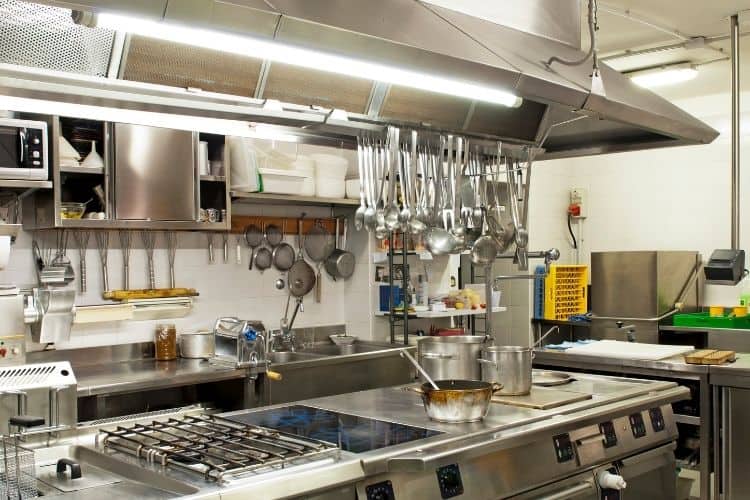
These are a few of the essentials every commercial kitchen will need to invest in:
- Eggs
- Ranges and ventilation
- Food processors
- Mixers
- Microwaves
- Slicers
- Grills
- Food prep counters and cutting boards
- Knife Sharpeners
- Freezers and refrigerators
- Safety equipment
- Storage racks and shelving
- Storage Containers
- Cooking equipment
- Servingware
- Sinks
- Washing equipment
Let’s dig into each of these in a little more detail:
Eggs
The backbone of any commercial kitchen, an oven is a must-have restaurant kitchen supply. You’ll require at least one oven with the ability to reach a high temperature, or as it’s more commonly known – a “hot” oven. The type of cooking that benefits most from a hot oven is baking and roasting.
It produces an even color on the surface of baked goods like bread and cakes and creates the perfect texture – crisp crusts and soft interiors. But there are many different types, and which oven you choose will depend on what type of food you’ll be serving.
Choosing the Right Oven
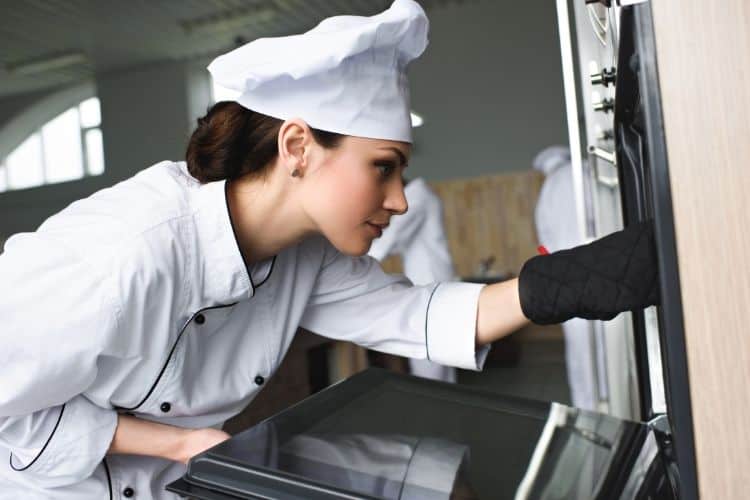
There will be a few key factors to consider before you pick your oven:
- Size – Size is key. If you own a family bakery, you most likely won’t need the same size oven as a 2-floor chain restaurant.
- Quality – Choosing higher quality appliances means they shouldn’t need to be replaced every few years. However, this will also depend on your budget.
- Features – Do you need an electric oven or a gas oven? Do you need certain features like temperature control or self-cleaning?
Next, you’ll need to decide what type of oven you need. Here are a few examples:
- Pizza oven – A favorite in Italian restaurants, this type of oven is often wood-fired and cooks pizzas quickly and evenly.
- Rotisserie – Used to cook large amounts of chicken, beef, or other meat for a low cost.
- Commercial oven – The most common type of oven. Usually seen in most restaurants, it’s perfect for cooking baked dishes.
- Combination oven – Used for almost any type of cooking. From steaming to frying or even smoking, the combi can certainly handle the heat.
- Conveyor oven – Used to cook sandwiches or pizzas – the food travels along the conveyor and it cooked evenly all over.
Ranges and Ventilation
Once you’ve picked your perfect oven, it’s time to start considering ranges and ventilation. Both of these are essential aspects of a commercial kitchen.
- Range Gas: This is a must-have for restaurant kitchens. Gas ranges are known for their temperature control; they reach the desired heat immediately and will continue working even through a power cut.
- Electric Range: Electricity is all about efficiency. These ranges take a little longer to heat up and cool back down, however, they tend to cook the food more evenly. They’re also much simpler to clean (many you can just wipe down) and reduce the risk of fire. They do come with hefty electricity bills though.
- Ventilation: Without a ventilation system, the restaurant kitchen would quickly turn into a hot, smoky, and pretty unbearable place. Designed to manage airflow and temperature control, ventilation systems will help keep a potentially hectic environment clean, and healthy for staff.
Food Processors
Used for many functions including chopping, slicing, and dicing, food processors can save a lot of time in a busy kitchen.
There are a few different types of food processors, but the most popular ones are:
- Batch bowl processor which is commonly found in households,
- Continuous food processor where you can keep adding food while it continues to chop,
- Combination processor, which is a bit of both
Mixers
For whipping up a tasty dessert, sauce, or soup, commercial mixers are a worthwhile investment. There are a few main types of mixers: the floor mixer which is used for large batches, the hand mixer which can be used for smaller quantities, and a countertop mixer for medium-sized spaces.
Microwaves

Whether it’s popping popcorn, warming plates before serving guests, or reheating sauces serving wares are often an important part of any restaurant kitchen. Microwave ovens come in all shapes and sizes so make sure you find the size best suited to your restaurant needs. Some restaurants even use small microwave ovens mounted under or above their counters.
Slicers
The job of the slicer is in the name. They are ideal for slicing meats or cheeses for restaurant sandwiches, entrees, and salads, or any other ingredients. There are many different types of meat slicers on the market – some with horizontal blade options that can be either manual or electric-powered while other models offer vertical blades for heavy-duty slicing tasks.
Grills
If you want those beautiful griddle lines on a steak, burger, or slice of halloumi cheese, you’ll need a top-notch grill to do it. Many of the best grills will also include a flat section which is great for cooking pancakes or frying the perfect egg.
However, grills can be rather chunky, only some restaurants opt for a standard hob-top and use high-end griddle pans to achieve the desired finish.
Food Prep Counters and Cutting Boards
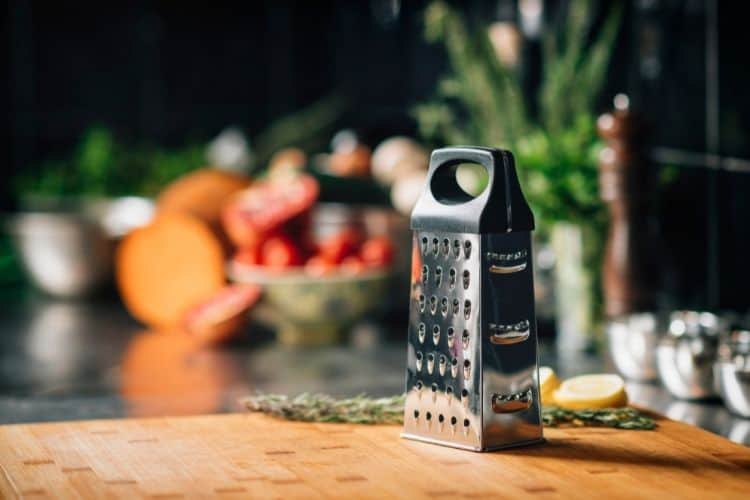
Even with all these fancy kitchen tools, you won’t get very far if your chefs don’t have space or equipment to prep the food. Worksurfaces and chopping boards are essential. Typically stainless steel worktops are easy to clean, won’t absorb bacteria, and will withstand harsher commercial cleaning products.
When it comes to chopping boards, plastic is the way to go. These are usually color-coded, depending on what they are used for. This helps maintain hygiene standards and prevents cross-contamination. Plastic is also easier to clean and usually dishwasher safe.
Knife Sharpeners
Quality kitchen knives are also essential to prep, but for keeping them sharp, you’ll need a knife sharpener. Most chefs sharpen their knives after every use or at least a couple of times per week. There are a few different sharpening options you can choose from – a traditional stone, a pull-through sharpener, an electric sharpener, or sharpening steel.
The sharpener you opt for will depend on your needs, the type of knives you have, and how familiar your chefs are with various sharpening techniques – for example, stones can be a little trickier to master but usually produce a shaper finish.
Freezers and Refrigerators
For keeping food as fresh as possible, you’ll need top-quality fridges and freezers. You may first need to consider the size and space that you have these units can be pretty huge. If you have lots of room, you could even consider a walk-in fridge, freezer, or both.
For easy access to prepped food during busy shifts, under-counter fridges and freezers are incredibly useful – chefs can just reach below their workstations to grab something they need. You can also buy freestanding fridges and freezes if you have a large space, but not quite enough for a walk-in.
Safety Equipment
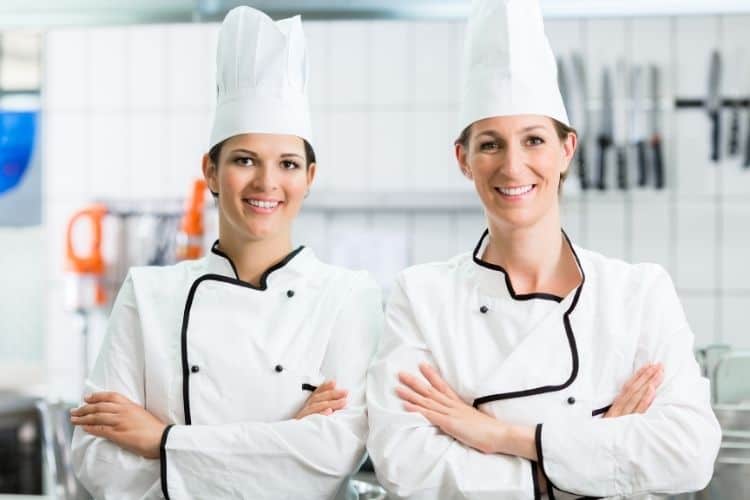
If you don’t follow correct safety proceedings in the kitchen, your establishment could easily be shut down. To follow the correct guidelines, staff will need the correct equipment. This includes:
- Fire extinguishers
- Hairnets
- Oven mitts
- Correct chef clothing, including chef whites and protective shoes
- First-aid kits (and training)
- Wet floor
- Rubber floor mats
You’ll also need to make sure that all your licenses and permits are up to date.
Storage Racks and Shelving
Stocking up on kitchen equipment involves buying a lot of stuff. So naturally, you’ll need storage for all of it.
This might include cabinets, shelving, drawers for utensils and knives, spice racks, and hooks. Not only will they help keep things organized but they’ll also free up counter space as well – which every professional chef knows is invaluable when prepping food. Plus, it will make cleaning easier to manage.
Storage units should be easy to access, and potentially mobile if you may need to move them in the future. However, this isn’t something you’re going to want to replace, so think carefully about your space and how to make the most of it before purchasing your storage solutions.
Storage Containers
This goes hand in hand with storage units. Containers are essential to keeping products fresh, free from bacteria and germs, and will help things last longer.
You’ll need:
- Bulk storage bins for keeping things like flour, rice, or fresh pasta
- Food storage containers – great for all kinds of prepped food, from homemade sauces to ready-sliced salad.
- Smaller storage bins for storing things like sugar and salt
- Vegetable crispers – perfect for items like homemade biscuits, melba toasts, or crackers.
Cooking Equipment
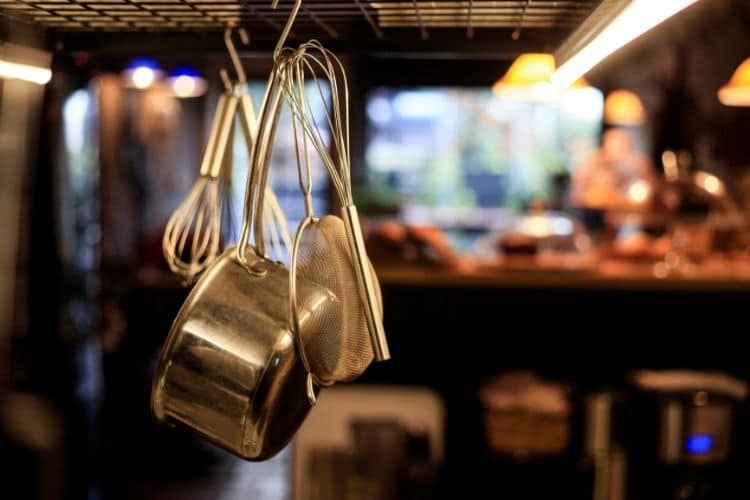
Unless you have the speediest pot wash in the world, you’re going to need to buy a lot of cooking equipment in bulk.
At the peak of service, chefs don’t have time to stop to wash every piece of equipment over and over again. So ideally, you’ll need to think about how much cooking equipment you’ll need for a single busy service without washing up.
You’ll need to consider:
- Pots and pans of all shapes and sizes
- Knives – both chefs knives and butter knives
- Spoons – both for serving and cooking
- Tongs – the kitchen essential
- Towels and rags
- Baking trays
- Mixing bowls
- Jugs
- Whiskeys
- Ladles
- Spatulas
- Serving utensils
Servingware
Once you’ve cooked all this delicious food, you’ll need dishes to serve it. Once again, you’ll need to stock up.
You’ll need:
- Plates – in various shapes and sizes
- Bowls – also in various sizes
- Cups and glasses – for all types of drinks from lattes to fancy cocktails (if you’re serving alcohol, of course)
- Forks, knives, and other cutlery – don’t forget latte spoons, soup spoons, and steak knives.
- Clothes, napkins, tablecloths
- Other crockery – ramekins, coffee mugs, teacups, and saucers, bread and butter plates, sauce dishes, cream or milk jugs.
- Other glassware like ice-cream sundae glasses
When it comes to how much serving ware to buy, think how many plates you’d need if the restaurant was full and your dishwasher was broken.
Sinks
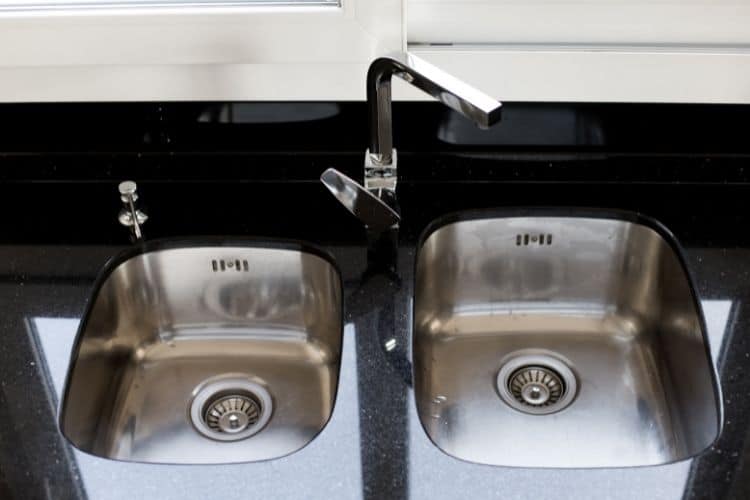
Even if the dishwasher is broken, you can always resort to good, old-fashioned hand-washing. But, in a commercial kitchen, you’ll need a sink for more than just doing the dishes.
Sinks are essential for hygiene and hand-washing and cleaning food products like fruits and vegetables. To meet health and safety requirements, you’ll likely need several handwashing sinks (depending on the size of your kitchen) and a larger commercial sink.
There are many different types of sinks that can be used in a commercial kitchen. This includes bar sinks, mop sinks, or even portable sinks.
Washing Equipment
Going hand-in-hand with sinks, washing equipment keeps your kitchen spotless. You’ll need:
- Mops and buckets,
- Brooms,
- Sponges,
- Rags,
- Various types of soaps and detergents,
- Bleach,
- griddle brushes,
- Available gloves,
- Dustpans and brushes
The Major Differences Between Restaurant Kitchen Supplies and Household Kitchen Supplies
You might be wondering why you can’t just buy regular kitchen equipment for your commercial kitchen. And, in some cases, you can.
The same spoons and cutlery can be used for both, and the same goes for crockery (on a much larger scale, of course). You could even use the same type of saucepans – well, some of them anyway – I doubt the average household has a 5-liter stockpot.
For smaller establishments, you might even be able to get away with household microwaves or blenders.
But when it comes to fridges, freezers, ovens, grills, and many of the other equipment on this list, buying from a commercial kitchen retailer is always better. So, let’s look at some of the pros and cons of restaurant-grade kitchen equipment.
Advantages of Restaurant Kitchen Supplies
Commercial kitchen supplies are designed for your restaurant. They are more powerful, bigger, and sturdier, and heavy-duty. They’re usually made from stainless steel or other tough materials which can withstand near-constant use without wearing out or getting damaged.
You can also find more specialist equipment for commercial kitchens such as dough stores or pizza ovens. And then there’s safety: the average home cook doesn’t need those extra-long oven gloves. While for use with commercial ovens, they can be a lifesaver.
Unless you’re a really unlucky cook, household users tend to have fewer risks and accidents than professional kitchens. As such, they typically have fewer kitchen repairs and need a much less stringent warranty on the equipment than what comes with typical commercial kitchen gear.
Disadvantages of Restaurant Kitchen Supplies
Commercial supplies are bulkier, harder to move around, and much more expensive.
They also typically have shorter warranties (although those warranties may cover more), they are more complicated to repair, and often trickier to use, and require staff training to ensure people are using equipment safely.
Commercial kitchen equipment is also much more demanding when it comes to cleaning needs, and will require frequent, thorough scrubbing. But when it comes down to it, the pros of commercial kitchen equipment vastly outweigh the cons, even with the added expense and staff training.
Restaurant Supplies Safety Tips

Staff training should be one of your top priorities as a restaurant owner, especially when it comes to kitchen equipment. Everyone who will be using the equipment must know how to use it safely. The best way to ensure this is through hands-on training.
This will ensure fewer injuries and health risks, which will result in faster, more efficient service, and happier customers who are more likely to come back.
Safety in the kitchen boils down to a few different things:
- Proper kitchen equipment
- Correct usage and maintenance of that equipment
- kitchen safety
- kitchen hygiene
These four things, combined with staff training, are the best way to prevent injuries in a kitchen. Remember to take these precautions into account so that your restaurant’s cooking space can be as safe and efficient as possible.
Hygiene
All staff should know basic hygiene measures to ensure the kitchen is cross-contamination and bacteria-free. It’s important to know things like what temperature the fridges and freezers should be at, what temperature different types of meat and other foods should be fully cooked, and how to correctly store prepped food.
You should also know which chopping boards are for what, how to use the equipment correctly to prevent injury to yourself and others, and how to comfortably use a knife. Training in all areas of the kitchen is key for hygiene and safety measures are met – both for customers and staff.
Wear PPE
Part of that training will be what to wear in the kitchen. Chefs need the correct gear and unlike some jobs, this isn’t just for uniformity.
Chef whites are usually flame resistant, which causes less of a risk if they are frequently over an open flame. They also protect kitchen workers from burns from hot food or hot oil and scolds from hot water.
Chef hats and hairnets are primarily about protecting the customer. Nobody likes finding hair in their food and wearing the correct headgear in the kitchen helps prevent this.
Anti-slip chef shoes serve two purposes: firstly, as the name suggests, they help prevent slips either from wet or greasy floors. Spills are common in busy kitchens, so wearing the proper footwear is essential. Secondly, they are usually made from a protective rubber or other material that will work to protect your feet from burns.
Inspection, Cleaning, and Maintenance
Cleaning is a daily task in a commercial kitchen. Every member of the team should be aware of their individual duties throughout the day.
After the morning prep, all worktops should be wiped (which is why making sure they are easy-to-clean stainless steel is so important), and stations cleared.
Throughout service, chefs should work as cleanly as possible, tidying up as they go, and keeping dirty things and empty containers away from the fresh food prep. Raw food should always be kept separate from cooked food.
At the end of the day, the sides should be wiped thoroughly again, all food should be correctly stored, the dishes should be washed, and the floor should be swept and mopped.
This is just on a day-to-day basis.
Once a week, the kitchen should be deep cleaned. Cupboards should be taken out and mopped behind, microwaves and other larger appliances should be moved and cleaned behind, the oil fryer should be emptied and replaced and the hobs, ovens, and thoroughly deep cleaned grills.
Chefs should also clean out the fridges and freezes regularly.
Be Sensible
Common sense is very important in a kitchen environment. For example, if you are cooking and will be working with grease or frying oil, it would make sense to wear a pair of long trousers or an apron as opposed to wearing shorts and a t-shirt.
If you are handling raw chicken, disposable gloves might need to be worn. And it’s never clever to mess around if you’re working with sharp knives. HACCP (Hazard Analysis Critical Control Point) plans to help reduce the chance of contamination from bacteria by monitoring all aspects of food production and storage closely.
This includes how often equipment needs to be cleaned between productions. But even though every kitchen should follow these guidelines, most accidents are down to human error. So, be sensible, and don’t be afraid to ask for help if you need it.
Best Kitchen Supplies for Your Restaurant
Here are a few of our top recommendations for restaurant kitchen supplies:
Rational SelfCooking Center 5 Senses
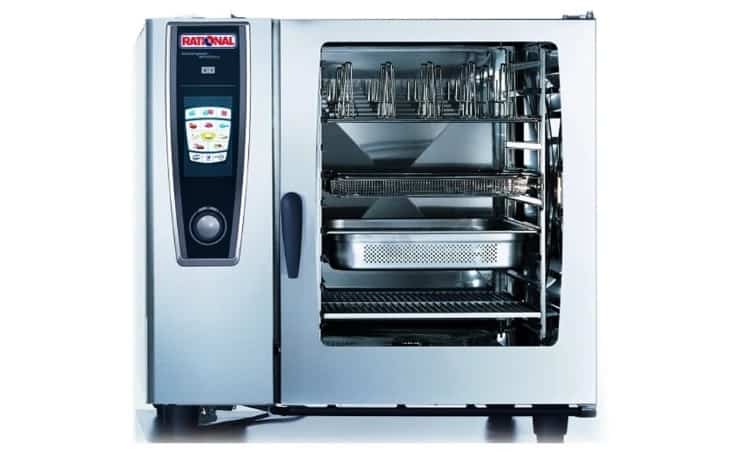
Rational is one of the world leaders in commercial kitchen combination ovens. They are dedicated to efficient, safe, and sustainable cooking. Their latest innovation is the Rational SelfCooking Center – an oven that does it all. It has 7 cooking modes; a steamer with 3 modes; an automatic cleaning & care system, and more:
- Measuring 555mm (d) x 655mm (w) x 567mm (h) – ideal for kitchens short on space
- self-cleaning feature
- Overnight cooking option, ideal for slow roasting
- Triple-glazed cabinet door
- LED lighting
- 300°C maximum cooking temperature
Lincat Lynx 400 LSC Superchef Infra-Red Grill
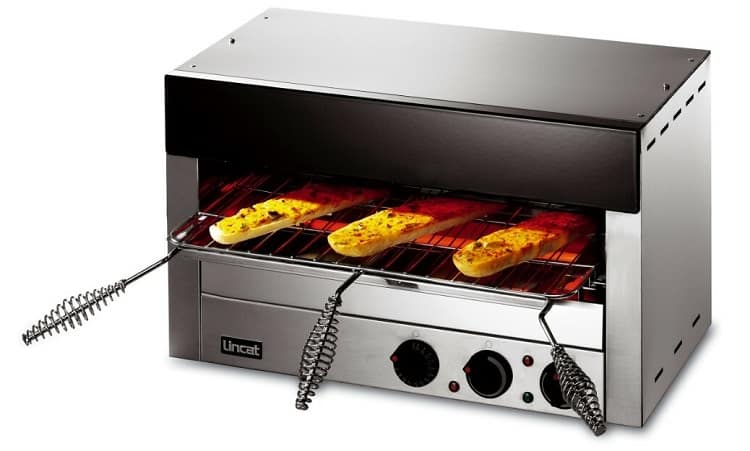
This Lincat Superchef Infra-Red Grill is a counter-top grill, ideal for all types of restaurant kitchens. Ideal for high-temperature cooking, you can cook pizzas, lasagna, or any other items that need to be browned on top in a fraction of the time it takes with conventional ovens.
The Superchef Infra-Red Grill features:
- Independent heat controls from the top and bottom of the unit help to manage temperature control and improve the evenness of cooking.
- Visible green and red lights show the user if the unit is switched on or still hot
- Speedy heat up – saves energy by switching on only when you need to use it
- Easy cleaning technology
- The six quartz infra-red elements provide a low voltage and attractively warm glow – this makes it great for front of house use
Kenwood Chef Titanium XL Stand Mixer KVL8300S
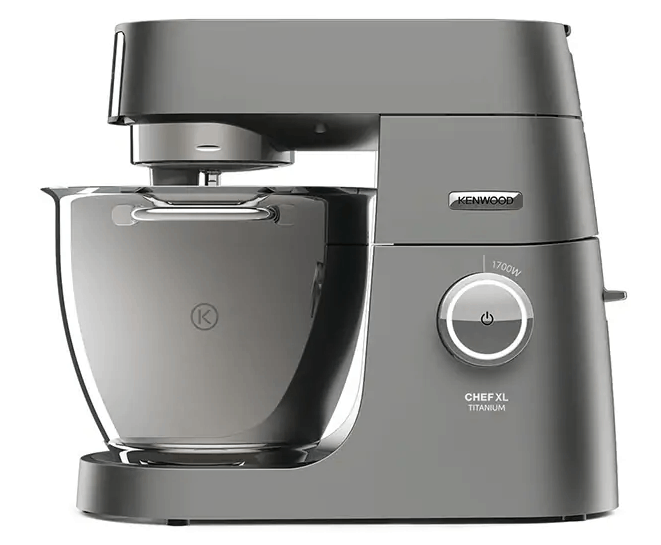
The Kenwood Chef Titanium is perfect for either commercial kitchens or even serious home bakers. Whether you’re whisking eggs, making pancakes, or folding dough, this mixer can do it all.
- Powerful motor – easily handles hard tasks like stiff dough and cookie batter with ease
- Large batch capability – up to 6.7 liters, so ideal for baking in bulk
- Easy-clean stainless steel makes maintenance easy
- The Illumination halo allows you to see the contents of the bowl when mixing
- A planetary mixer ensures that you don’t have to finish mixing the ingredients in the bowl by hand; the special action rotates the dough, ensuring all contents are well-mixed.
- It’s supplied with a splash guard, a power whisk, a spiral dough hook, and an additional regular beater, but other attachments can be bought to make it even more versatile
Chef’sChoice 0101500 15 Trizor XV EdgeSelect Professional Electric Knife Sharpener
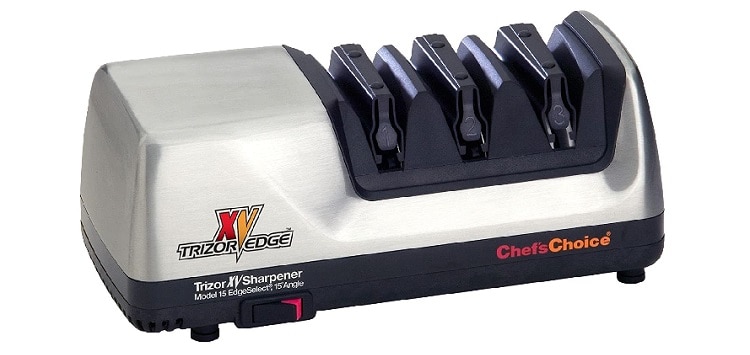
This sharpener is easy to use and more durable than most. It can convert your 20-degree knives to a higher-performance 15-degree angle with ease. It has a three-stage sharpening blade – one to create the bevels and a second to polish the blade. It can also be used for both straight and serrated knives.
- Flawless, ultra-sharp 15-degree XV technology
- The sharpener offers automatic adjustment of the cutting angle and a simple on/off switch for quick, accurate, easy operation.
- Sharpening the knife initially takes about a minute, and subsequent sharpening is about 10 seconds.
- The 3-Stage EdgeSelect sharpening system is an optimum tool for edge sharpening. This will provide the best edge for any cutting task.
- Compact for easy storage at 25.4 x 10.8 x 10.8 centimeters
FAQs
Question: Is Kitchen Equipment Energy Efficient?
Answer: Kitchen equipment can be energy efficient. Energy efficiency is a desirable factor when choosing restaurant kitchen supplies and not opting for energy-saving options can end up costing a fortune. Look for an A+ rating when you purchase equipment and consider water and fuel efficiency too.
Question: Should I Buy New or Second-Hand Kitchen Equipment?
Answer: This will ultimately depend on your budget, but overall, new kitchen equipment will have a longer lifespan than second-hand. It will also give you the full warranty instead of having to shell out for repairs if something goes wrong.
Question: How Much Maintenance and Upkeep is Needed for Kitchen Equipment?
Answer: Restaurant kitchen equipment requires a lot of upkeep. Weekly cleaning is important and will dramatically extend the life of your equipment.
Question: How Much of The Restaurant Kitchen Supplies Cost?
Answer: Kitchen supply pricing will always depend on your needs. If you’re just getting started in the business, then you might want to start with some less expensive items until cash flow allows purchases of pricier things.
Nevertheless, items like a combi oven and grill can still cost thousands of dollars depending on what size and quality you want. Regardless of cost, it’s always best to buy something that will last as opposed to something cheaper than you’ll have to replace in a couple of years.
Conclusion
Catering can be a very busy, challenging, but satisfying trade. If you’re just starting with your restaurant, then it can be hard to know where to start when it comes to restaurant kitchen supplies.
But with a little guidance, you can hone your craft, serve some beautiful dishes, and create some lifelong, happy customers. We hope you’ve found this ultimate guide to restaurant kitchen supplies helpful and is now ready to jump fork-first into the catering world.

